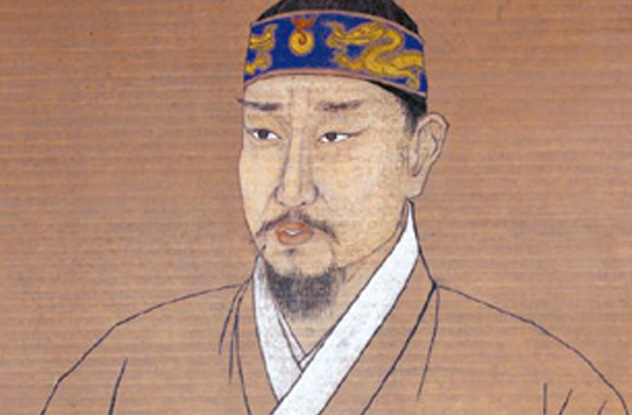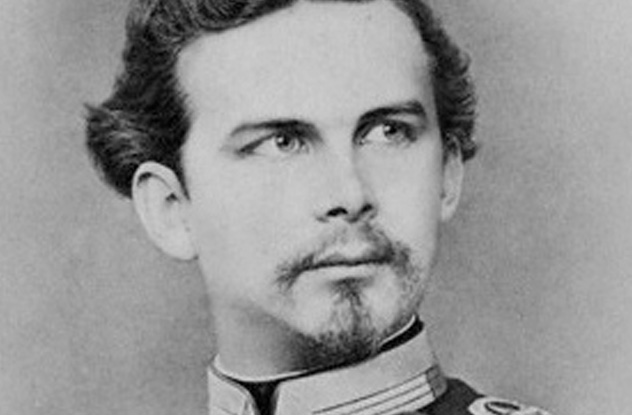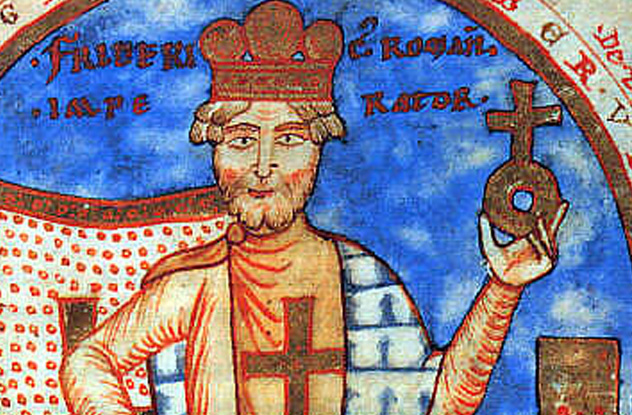10 King James II Of Scotland
James II ruled Scotland for 23 years between 1437 and 1460. His reign is generally looked upon favorably. Acts such as the foundation of the University of Glasgow made him a popular king, but he was also responsible for reprehensible acts such as the murder of the Earl of Douglas. In fact, James showed that he was willing to get rid of anyone who threatened his rule. Even though the Scottish War of Independence was over by the 15th century, certain areas around the border regions remained under British control. One of them was Roxburgh Castle. King James thought that he would be able to reclaim this castle for Scotland at a time when English forces were weakened by the War of the Roses. This would prove to be a fatal mistake on James’s behalf. James was killed by a cannon during the siege. At first glance, this isn’t a particularly odd death. After all, cannons are designed to kill. However, the cannon in question was one of his own. A passionate fan of artillery, James II imported cannons from Flanders and was keen to see them in action. He was standing right next to one when, instead of shooting, it exploded. The scene is best described by 16th-century Scottish historian Robert Lindsay of Pitscottie: “The king stood near a piece of artillery. His thigh bone was dug in two with a piece of misframed gun that brake in shooting, by which he was stricken to the ground and died hastily.”
9 King Charles VIII Of France
Charles VIII (also known as Charles the Affable) had a 15-year reign as king of France between 1483 and 1498. Since he was only 13 years old when he took the throne, his elder sister Anne and her husband, the Duke of Bourbon, ruled as regents for half of his reign. His tenure as king was rather bland. As one would expect from an inexperienced child, Charles showed little interest in politics and government. To strengthen his position, he made numerous concessions to the various monarchies surrounding his kingdom, which did help improve the relationship between France and the Italian regions. His death is probably the most eventful aspect of his reign as it occurred during a game of tennis. He wasn’t playing. He was attending a match at Amboise, when he failed to notice a low doorway. He walked right into it and struck his head on the lintel of the door. He initially recovered but fell into a coma after the game and died a few hours later.
8 Empress Elisabeth Of Austria
Before her assassination, Elisabeth (or “Sisi,” as she was known) enjoyed one of the longest reigns in Austrian history. As the wife of Emperor Franz Joseph I, Elisabeth held the position of Empress of Austria and Queen of Hungary for 44 years. This was until September 10, 1898, when she was murdered by a man called Luigi Lucheni. It was a case of wrong place, wrong time. By his own admission, Lucheni had nothing against Elisabeth personally. The Italian anarchist simply despised all royalty and wealthy people in general. His intended target was Prince Philippe, Duke of Orleans. Unfortunately for everyone involved (except the duke), Lucheni arrived too late in Geneva, and he missed his opportunity. He then grabbed a newspaper and looked for the next best target in town, who just happened to be Elisabeth. He found out where she was staying, went to the hotel, and waited for her. When Elisabeth came out, Lucheni approached her and stabbed her in the heart. He then gave himself up, quite proud of his actions. He asked to be extradited to Italy and to receive a public execution worthy of a martyr. The government, not quick to do him any favors, denied his request. He then hanged himself in his cell.
7 King Alexander Of Greece
No, not that Alexander. We’re talking about the King Alexander who ruled over Greece in the early 20th century. He only had a short three-year reign before his untimely demise at age 27—by a monkey bite. The monkey in question, a Barbary macaque, was a pet who lived at the palace along with other animals. One day, Alexander was walking his dog when the animal got into a fight with one of these monkeys. Alexander tried to break up the fight, and one of the macaques bit him. Initially, the wounds were not considered very serious. They were cleaned and dressed, and the king asked that the entire event be forgotten (although the monkey was still killed). The wound was not cleaned properly, and it got infected later that same day. The king was bedridden with severe sepsis. His life could have probably been saved if one of his physicians amputated his leg, but none of them wanted to take such a drastic measure, so they tried other methods of combating his illness. After a long fight that lasted over three weeks, his condition became too much. Alexander died on October 25, 1920.
6 Prince Sado
Living in the late 18th century, King Yeongjo of Joseon was one of the most successful and long-lived rulers in Korean history. He reigned for 52 years, during which he implemented a new taxation system and tried to minimize fighting between factions by adopting a Confucian mentality. However, he is mostly remembered by many today for the execution of his son. Yeongjo could not allow his son, Sado, to rule after him. The young man was deeply unstable and prone to violent outbursts. He became known and feared around the kingdom as a serial rapist and killer. He first started beating his own servants, then killing them, and then raping women of the court. Finally, he just did whatever he wanted with whomever he encountered. Yeongjo knew that the law forbade him from killing his son, but he was allowed to depose him with consent from his mother. After he did so, he sentenced Sado to be locked inside a heavy chest used for storing rice. It was opened eight days later once Sado had died of suffocation.
5 King Ludwig II Of Bavaria
Ludwig was known as the original “Mad King,” but he didn’t really deserve the moniker. All he really did was ignore politics in favor of the arts. He cared little about ruling, even while his kingdom was being subjugated by Prussia. His priority was building incredibly lavish castles where his favorite composers could perform. He was especially fond of Richard Wagner. To pay for all his extravagances, Ludwig borrowed heavily from foreign banks. When they threatened to seize his property, Ludwig simply ignored them, hoping they would go away. Because of his refusal to deal with this problem, his government eventually elected to have the king declared insane in 1886. He was to be interned at Berg Palace near Lake Starnberg, but just a few days later, he died under mysterious circumstances. To this day, we don’t know what killed him. The king went for a stroll accompanied only by his physician, who had declared him insane. A few hours later, both men were found dead. The king’s death was ruled a suicide, the official story stating that he killed the doctor and then drowned himself. However, almost immediately, talks of conspiracies appeared. Modern professionals disagree with the initial autopsy, which was rushed and sloppy. Moreover, several accounts mention that the king’s coat mysteriously had two bullet holes. The coat was taken from the body and reportedly made several appearances with different owners afterward.
4 Holy Roman Emperor Frederick I
Frederick I, also known as Frederick Barbarossa, was first elected King of Germany in 1152 and later also became King of Italy before finally being crowned Roman Emperor in 1155. He had a 35-year reign as emperor, most notable for his participation in the Crusades. During the Third Crusade to the Holy Land in 1190, Frederick met his demise. Frederick was leading his German troops into Turkey to face Saladin. The sultan was already rallying forces from other Muslim leaders in anticipation of the encounter. However, Frederick would never reach Saladin. He foolishly perished in a river. His army reached the Goksu River in Turkey, which back then was known as “Saleph.” His advisors recommended that they find a bridge to cross the turbulent water, but Frederick insisted that the river could be crossed on horseback. Keen to prove himself right, the king was the first to plunge into the river, but his horse could not handle the currents. The king was also not strong enough to swim because he was wearing heavy armor. Both man and horse drowned.
3 Frederick, Prince of Wales
Frederick was the son of George II and the father of George III. Both his father and his son got to rule the United Kingdom as king, but Frederick never got the chance because he died before his father. This certainly didn’t bother King George II or his wife, who both absolutely despised their eldest son. Queen Caroline on her deathbed was reported to say of him: “At least I shall have one comfort in having my eyes eternally closed—I shall never see that monster again.” Since he wasn’t involved in the nation’s politics, Frederick had time to dedicate himself to other passions, such as sport. Particularly, he was a massive fan of cricket, and this was his undoing. Frederick died in 1751 of a burst abscess, aged 44 (nine years before his father). Reports mention that the abscess was caused by a cricket ball that hit the prince during a game. As it turned out, Frederick was only one in a line of bizarre deaths that plagued his family.
2 Queen Caroline Of Ansbach
Frederick’s mother, Queen Caroline, was subjected to an even more bizarre (and extremely unpleasant) death. In her final years, the queen became quite a corpulent woman. She suffered from gout so severe that she was usually carried around the palace in a decorated wheelchair. She also developed medical problems after the birth of her youngest child. The cause of her suffering was a strangulated hernia. One day, the pain was so intense that it left her completely bedridden. Her womb had ruptured, and she was bleeding internally. This led to her death on November 20, 1737, when her bowels burst wide open. Her death, while gruesome and extremely painful, was made even worse after it was immortalized in an infamous epigram, commonly attributed to 18th-century poet Alexander Pope (although the actual origin is disputed): “Here lies, wrapt up in forty thousand towels/The only proof that Caroline had bowels.”
1 King Charles II Of Navarre
Charles II, who ruled the kingdom of Navarre between 1343 and 1387, was an opportunist looking to exploit the Hundred Years’ War between England and France. He often switched sides to suit his needs, earning him the nickname Charles the Bad. His ghastly death was ruled by many as divine punishment. Several accounts that differ slightly have been given of his death, but the most quoted one is that of 18th-century English author Francis Blangdon. According to him, Charles was very ill, and his physician ordered him to be completely wrapped from neck to toe in linen cloth soaked in brandy. One of the doctor’s attendants was sewing up the cloth so that it would be nice and tight. When she finished, she wanted to cut the remaining thread. Since this treatment was performed at night, she didn’t want to use scissors in case she cut the king. Instead, she decided to burn off the thread with a candle. The linen was completely soaked in brandy, so when the lit wick came close, the king went up in flames. Radu is a freelance writer who enjoys covering bizarre and unusual topics. He also writes more interesting stuff at GeeKiez and uses Twitter to converse with you.
























